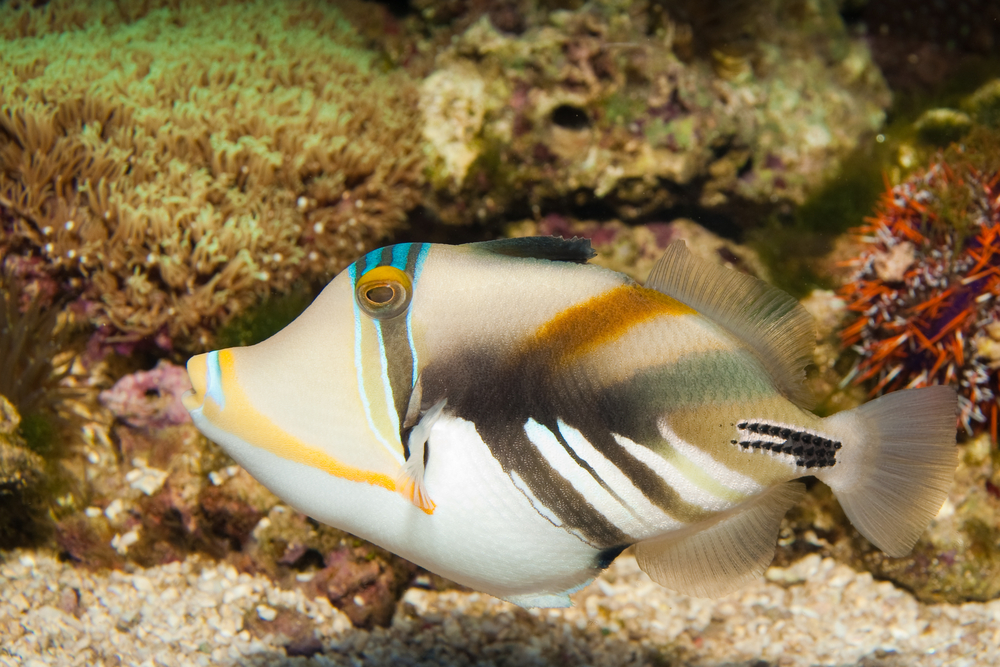Every state has a designated fish, some common, others unique.
It’s hard to imagine the state of Hawaii, surrounded by beautiful white sand beaches, breathtaking reefs, and countless extraordinary sea life, being able to name a state fish.
There are many to choose from, but they have settled on one.
The state fish of Hawaii has a 21-letter moniker that takes some effort to say correctly. The humuhumunukunukuapuaa is its official name.
“Who moo who moo new coo new coo ah poo ah ah” is how the Hawaiians say the lengthy title of this fish. To learn more about the Humuhumunukunukuapuaa and what makes it so unique to the Hawaiian people, read on.
Table of Contents
Why is a triggerfish the Hawaii state fish?
Hawaii’s state fish, the humuhumunukunukuapuaa (humuhumu in short) or reef triggerfish, is one of the most widely recognized Hawaiian reef fish because of its distinctive color, fin arrangement, and angular body shape.
The humuhumu was selected by a public survey as Hawaii’s official state fish in 1984. School children were instrumental in campaigning for the humuhumu.
When the humuhumu was initially chosen as the state fish, lawmakers only made this designation official for five years. So, for over a decade, the humuhumu lost its reign as the state fish.
A re-election campaign resulted in the humuhumunukunukuapuaa permanently becoming Hawaii’s official state fish in 2006. Many Hawaiian locals joke that the fish’s name is longer than the actual size of the fish!
How did Hawaii’s state fish get its long name?

The state fish’s title has a deep significance and history, just like all Hawaiian names. The Hawaiian term for all triggerfish species is “humuhumu,” which you can break down into its constituent parts.
Nukunuku Apua’a, the second part of the name, means “snout like a pig.”
Triggerfish with a pig-like snout is what the term “humuhumunukunukuapuaa” means. Although it may seem unusual, the distinct grunting sound that live fish make when threatened resembles the unmistakable sounds of pigs.
The singular and plural forms of the name humuhumunukunukuapuaa are interchangeable. Lagoon triggerfish (R. aculeatus) gets to share its Hawaiian moniker with this fish, which you can also find in the Indo-Pacific.
What is the legend of the state fish of Hawaii?
The humuhumunukunukuapuaa appears in Hawaiian mythology. The shape-changing demigod Kama Puaa, who can also assume the appearance of a man or a wild boar, is strongly related to the fish.
Kama Pua’a, according to legend, was a brutal O’ahu chief.
Pele, the Hawaiian goddess of fire and lava, caught his eye one day when he decided to visit the Big Island. He met the woman of his dreams, and the rest is history.
It was after Pele confronted Kama’s brutality that the goddess determined enough was enough.
An epic duel between Kama Pua’a and Pele ensued, and as a result, Pele unleashed lava and steam. The situation forced Kama Pua’a to flee into an ocean distant from the lava pits after Pele summoned reinforcements.
It didn’t take him long to transform from human to marine creature and make his way to safety.
What is the origin of the name “triggerfish”?

The spines on the dorsal fins of the triggerfish give the species its popular name. When disturbed, the triggerfish will dive into a narrow aperture, raising and latching the first spine to anchor itself in place.
As soon as the second spine lowers, the first spine is unlocked.
What is the humuhumu’s routine?
In the depths of the ocean, the humuhumu spends its days feeding on algae and scavenging for invertebrates that get buried in the sand.
In the evening, it returns to the reef nook where it lives and stretches up to three spines that remain largely intact until morning.
The fish will sleep well at night, knowing that it is safe from harm. Wedge-tail Triggerfish is another frequent name for humuhumu because of this activity.
Shallow, outer-reef habitats are preferred by the humuhumu, making them ideal fish to search for by beginner snorkelers.
Is it safe to swim near or watch the humuhumu?
Because of its distinctive coloration and patterning, the humuhumu is easy to spot.
In the wild, you can see humuhumu in Oahu’s Hanauma Bay, located on the island’s southern shores.
In contrast, reef triggers, which may grow up to 30 centimeters in length, are aggressive and solitary. In captivity, this is especially true. Their colors can change quickly to reflect their moods and motivation.
Napping or displaying passivity might make them appear dull, but their coloring is frequently most vibrant when unaffected by their environment.

They’re also known to attack and bite swimmers in the vicinity, usually around the ankle, and sometimes even leave marks on them due to the assault.
Is it possible to eat the state fish of Hawaii?
It is possible to catch these fish, and as of now, there is no catch limit. These fish don’t have an endangered or a threatened species status. Despite being the official state fish, they are not subject to any special regulations.
Although the humuhumu is palatable and was eaten by early Hawaiians, many people today would rather catch and eat fish that are considered tastier, like tuna or ahi.
How can you tell humuhumu apart?
Reef triggerfish are tiny fish that grow to a maximum length of 8 inches. Because larger predatory fish frequently prey on them, their bodies have evolved to make it easier for them to camouflage.
Because of its flat, slender body and the ability to alter its skin color, the humuhumu is excellent at concealing itself. It is common for them to hide in the cracks of rocks and coral.
In the open, their bodies stay covered in black, yellowish, and grayish hues. Rare for most fish, humuhumu actually have distinct front teeth.
The teeth are blue and sit below the fish’s blue-tinged top lip and are close together in their rather large mouths.
Are predators an issue for humuhumu?

An additional dorsal spine on the fish serves to keep the fish’s primary spine erect when it’s swimming. The fish stays protected from predators by locking its spine while hiding in a small fissure.
The grunting noises the triggerfish may make when escaping from predators accompanies water that it jets from its mouth to deter its pursuers.
When hunting, the triggerfish searches for benthic invertebrates that might hide beneath the water’s surface.
It is also common to see triggerfish sifting through debris – frequently using their lips and spitting sand out of their mouths – in search of food.
Is the state fish of Hawaii a native species?
Reef triggerfish inhabit the Indo-Pacific region, extending from 30 degrees north to 30 degrees south in latitude. As far south as the Red Sea and Africa, you can find reef triggerfish.
What is the humuhumu’s natural habitat?
For the most part, you can find reef triggerfish in shallow outlying reef settings. Surge-swept basalt reefs are ideal habitats for this bottom-feeding fish. Rough reef flats and lagoon protection areas frequently have triggerfish.
These fish prefer waters with salinity levels that range from 1.020 to 1.023 and a temperature range from 77–80° F.
How does the state fish of Hawaii breed?
The reef triggerfish reproduces in a heterosexual manner, with distinct male and female parents, like most fish.
The female reef fish lays eggs, which are then outwardly impregnated by the sperm from the male.
After fertilization, the female fish guards the eggs in a nest that she has created and then continues to care for the offspring after they hatch.
What does the humuhumu eat?
The humuhumu is known for its ability to devour a variety of foods. Invertebrates and algae make up the bulk of the reef triggerfish’s diet. Small crustaceans, worms, brittlestars, sea urchins, and snails are some of the most common foods that triggerfish enjoy.
Other fish, corals, tunicates, forams, and eggs are uncommon dietary supplements.
Reel triggerfish may feed on a wide variety of crustaceans, snails, and fish, thanks to their vast range of feeding options. For the most part, reef triggerfish feed by rummaging through the sand or pebbles.
What is the significance of the humuhumu in the Hawaiian economy?

Reef triggerfish, which you can catch with drive-in nets, are a minor bycatch for commercial fisheries, but they are a valuable addition to aquariums.
Since they are uncompromising and straightforward to care for, reef triggerfish are popular aquarium fish. The fish’s propensity to eat a range of foods, including live, frozen, and flake, makes it a popular choice for aquariums.
The reef triggerfish can adapt to a wide range of environmental circumstances due to its lack of specific temperature or light needs.
In addition to its distinctive markings and brilliant color, the reef triggerfish is notable owing to its simplicity of capture and availability for purchase. In comparison to other triggerfish, the reef triggerfish has a pleasant personality.
Many people do not appreciate reef triggerfish as a commercial food source. For most of Hawaiian history, it was an uncommon delicacy.
It was also used as a fuel for cooking by indigenous Hawaiians when other forms of energy were scarce. The reef triggerfish became part of religious rituals in place of pigs, which was significant.
Is the state fish of Hawaii in danger of extinction?
The reef triggerfish is not under threat because of its abundance in a wide range of marine settings.
Many of these ecosystems, however, are undergoing significant transformations that have the potential to drastically lower the humuhumu’s populations.
Reef triggerfish and other marine animals are under threat from human population expansion and the circumstances that accompany it, as well as from tropical fish collectors.
Abiotic forces are reducing other creatures in many of the reef triggerfish environments, but they are not in danger right now.
















